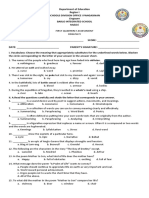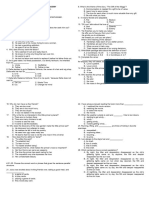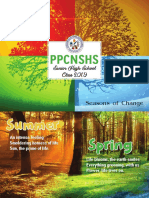0 ratings0% found this document useful (0 votes)
59 viewsThe Raven (By Edgar Allen Poe) The Raven (By Edgar Allen Poe)
This document contains an English summative test with multiple sections. Section I asks students to identify sounds in words. Section II asks students to identify rhyme schemes and poetic devices in poems. Section III asks students to identify onomatopoeia. Section IV asks students to choose the best paraphrase of passages. The test contains questions on English language concepts like phonics, literary analysis, figures of speech, and paraphrasing.
Uploaded by
Aman AmyrCopyright
© © All Rights Reserved
Available Formats
Download as DOCX, PDF, TXT or read online on Scribd
0 ratings0% found this document useful (0 votes)
59 viewsThe Raven (By Edgar Allen Poe) The Raven (By Edgar Allen Poe)
This document contains an English summative test with multiple sections. Section I asks students to identify sounds in words. Section II asks students to identify rhyme schemes and poetic devices in poems. Section III asks students to identify onomatopoeia. Section IV asks students to choose the best paraphrase of passages. The test contains questions on English language concepts like phonics, literary analysis, figures of speech, and paraphrasing.
Uploaded by
Aman AmyrCopyright
© © All Rights Reserved
Available Formats
Download as DOCX, PDF, TXT or read online on Scribd
You are on page 1/ 2
ENGLISH 9
SUMMATIVE TEST ENGLISH 9
SUMMATIVE TEST
I. Direction: Identify the sound of the following words.
I. Direction: Identify the sound of the following words.
1. zoo - ________
2. sooth - ________ 1. zoo - ________
3. shoe - ________ 2. sooth - ________
4. four - ________ 3. shoe - ________
5. sure - ________ 4. four - ________
5. sure - ________
II. Direction: Identify the end rhyme and internal rhyme in
the following poems. II. Direction: Identify the end rhyme and internal rhyme in
the following poems.
1. “Once upon a midnight dreary, while I pondered, weak
and weary, 1. “Once upon a midnight dreary, while I pondered, weak
While I nodded, nearly napping, suddenly there came and weary,
a tapping, While I nodded, nearly napping, suddenly there came
As of someone gently rapping, rapping at my chamber a tapping,
door. As of someone gently rapping, rapping at my chamber
Tis some visitor,” I muttered, “tapping at my chamber door.
door… Tis some visitor,” I muttered, “tapping at my chamber
door…
The Raven (By Edgar Allen Poe)
The Raven (By Edgar Allen Poe)
2. “Double, double toil and trouble,
Fire burn and cauldron bubble…” 2. “Double, double toil and trouble,
Fire burn and cauldron bubble…”
Macbeth (By William Shakespeare)
Macbeth (By William Shakespeare)
3. Bid me to weep, and I will weep
While I have eyes to see 3. Bid me to weep, and I will weep
And having none, yet I will keep While I have eyes to see
A heart to weep for thee And having none, yet I will keep
A heart to weep for thee
To Anthea, who may Command him Anything by Robert
Herrick: To Anthea, who may Command him Anything by Robert
Herrick:
III. Direction: Identify the onomatopoeia in the following
sentences. III. Direction: Identify the onomatopoeia in the following
sentences.
1. Alone in the house, Sara became alarmed when
she heard a thumping noise overhead, and the 1. Alone in the house, Sara became alarmed when
thud of someone coming down the stairs. she heard a thumping noise overhead, and the
2. The dead leaves on the ground rustled in the thud of someone coming down the stairs.
cool, crisp fall wind. 2. The dead leaves on the ground rustled in the
3. The ring of my alarm clock does not wake me cool, crisp fall wind.
up, but my mother’s screeching that breakfast is 3. The ring of my alarm clock does not wake me
ready does the trick. up, but my mother’s screeching that breakfast is
4. The smell of the bacon wafted to me, and I could ready does the trick.
hear the sizzling of the grease as it fried. 4. The smell of the bacon wafted to me, and I could
5. Marie just giggled at my joke, but Mark snorted hear the sizzling of the grease as it fried.
milk through his nose. 5. Marie just giggled at my joke, but Mark snorted
B. Identify the following ASSONANCE, ALLITERATION, milk through his nose.
& CONSONANCE in the following sentences. B. Identify the following ASSONANCE, ALLITERATION,
& CONSONANCE in the following sentences.
1. Which of the following is an example of
ASSONANCE? 1. Which of the following is an example of
a. The rain fell plippity plop. ASSONANCE?
b. Billy built a beautiful boat. a. The rain fell plippity plop.
c. Hey, do you know the way to my favorite state? b. Billy built a beautiful boat.
d. Truth is a chocolate cake. c. Hey, do you know the way to my favorite state?
2. d. Truth is a chocolate cake.
Which of the following is an example of 2.
ALLITERATION? Which of the following is an example of
a. My heart is an open invitation. ALLITERATION?
b. Let me just say my mom made a mistake. a. My heart is an open invitation.
c. I am happy to walk you back to class. b. Let me just say my mom made a mistake.
d. Go! Go! Go! c. I am happy to walk you back to class.
d. Go! Go! Go!
3. Identify the CONSONANCE in the poem.
If you want to marry me, here’s what you’ll have to do: 3. Identify the CONSONANCE in the poem.
You must learn how to make a perfect chicken dumpling If you want to marry me, here’s what you’ll have to do:
stew. You must learn how to make a perfect chicken dumpling
stew.
IV. Direction: Choose the best paraphrase in the
IV. Direction: Choose the best paraphrase in the following.
following.
1. “In short, adoption is a ubiquitous social institution in
1. “In short, adoption is a ubiquitous social institution in American society, creating invisible relationships with
American society, creating invisible relationships with biological and adoptive kin that touch far more people
biological and adoptive kin that touch far more people than we imagine.” (Paragraph 1)
than we imagine.” (Paragraph 1) a. In America, more people are adopted than was
a. In America, more people are adopted than was originally thought.
originally thought. b. Adoption touches a surprising number of people
b. Adoption touches a surprising number of people throughout American society. c. Because adoptees are
throughout American society. c. Because adoptees are “invisible,” their circumstances are hard to imagine.
“invisible,” their circumstances are hard to imagine. d. Relationships between biological and adoptive kin have
d. Relationships between biological and adoptive kin have international scope.
international scope.
2. “While raising a family is inherently stressful, adoption
2. “While raising a family is inherently stressful, adoption is filled with additional tensions that are unique to the
is filled with additional tensions that are unique to the adoptive relationship.” (Paragraph 2)
adoptive relationship.” (Paragraph 2) a. Families that adopt children can avoid some of the
a. Families that adopt children can avoid some of the tensions inherent in biological families.
tensions inherent in biological families. b. Raising a family under stressful condition scan
b. Raising a family under stressful condition scan discourage potential adoptive parents.
discourage potential adoptive parents. c. The adoptive relationship is inherently stressful.
c. The adoptive relationship is inherently stressful. d. Families with an adopted member face more
d. Families with an adopted member face more challenges than biological families.
challenges than biological families.
3. “Third, in a nation that sanctifies blood kinship, adoptive
3. “Third, in a nation that sanctifies blood kinship, adoptive families and adoptees are stigmatized because of their
families and adoptees are stigmatized because of their lack of biological relationship.” (Paragraph 2)
lack of biological relationship.” (Paragraph 2) a. Nations that sanctify blood relationships are often
a. Nations that sanctify blood relationships are often stigmatized.
stigmatized. b. Adoptive families and adoptees are treated like
b. Adoptive families and adoptees are treated like criminals in nations that over-value blood relationships.
criminals in nations that over-value blood relationships. c. Where blood kinship is excessively valued, adoption is
c. Where blood kinship is excessively valued, adoption is considered inferior.
considered inferior. d. In some nations, adoptees do not have the same legal
d. In some nations, adoptees do not have the same legal relationship to their adoptive parents as blood kin have to
relationship to their adoptive parents as blood kin have to their birth parents.
their birth parents.
4. “Opposing these adoptees, some birth mothers argued
4. “Opposing these adoptees, some birth mothers argued that they were promised secrecy when they relinquished
that they were promised secrecy when they relinquished their children for adoption and that abrogating that
their children for adoption and that abrogating that promise constituted an invasion of privacy.” (Paragraph 3)
promise constituted an invasion of privacy.” (Paragraph 3) a. Some birth mothers who were promised secrecy about
a. Some birth mothers who were promised secrecy about their role felt that breaking that promise was an invasion
their role felt that breaking that promise was an invasion of their privacy.
of their privacy. b. In order to retain their privacy, some birth mothers
b. In order to retain their privacy, some birth mothers refused to reveal their identities when they relinquished
refused to reveal their identities when they relinquished their children for adoption.
their children for adoption. c. Some adoptees support their birth mothers’ right to
c. Some adoptees support their birth mothers’ right to secrecy, even if it was promised to them when they gave
secrecy, even if it was promised to them when they gave their children for adoption.
their children for adoption. d. Some birth mothers felt that their biological children’s
d. Some birth mothers felt that their biological children’s pursuit of their identities should be abandoned based on
pursuit of their identities should be abandoned based on the possibility that the birth mother requested privacy.
the possibility that the birth mother requested privacy.
Paraphrase these sentences.
Paraphrase these sentences.
5. “Second, since World War II, the entire edifice of
5. “Second, since World War II, the entire edifice of modern adoption has been enveloped in secrecy.”
modern adoption has been enveloped in secrecy.”
You might also like
- The Gaelic Manuscripts - Stewart Edward White100% (3)The Gaelic Manuscripts - Stewart Edward White164 pages
- 5 Paragraph Essay - Expository Essay ModelNo ratings yet5 Paragraph Essay - Expository Essay Model1 page
- Lord El-Melloi II Case Files - Volume 01 (TwilightsCall) (Toshiyashiro - Calibre)No ratings yetLord El-Melloi II Case Files - Volume 01 (TwilightsCall) (Toshiyashiro - Calibre)403 pages
- Researchers Map The Sexual Network of An Entire High School100% (1)Researchers Map The Sexual Network of An Entire High School5 pages
- The Influence of Role Strain On Stepfamily AdjustmentNo ratings yetThe Influence of Role Strain On Stepfamily Adjustment12 pages
- ENGLISH 9 Q2-MODULE 7 Identifying Types and Features of Short ProseNo ratings yetENGLISH 9 Q2-MODULE 7 Identifying Types and Features of Short Prose21 pages
- Argumentat Ive Essay: Atira Syafikah Shameen Farah Nabila Azizan Anisah Natasya Muhammad AlifNo ratings yetArgumentat Ive Essay: Atira Syafikah Shameen Farah Nabila Azizan Anisah Natasya Muhammad Alif11 pages
- English Writing Skills and CommunicationsNo ratings yetEnglish Writing Skills and Communications3 pages
- 1st Quarterly Assessment-English 9-S.y.2019No ratings yet1st Quarterly Assessment-English 9-S.y.20194 pages
- Table of Specifications g9 English 1st QTRNo ratings yetTable of Specifications g9 English 1st QTR9 pages
- First Grading Test English 2019 2020 With Answer KeyNo ratings yetFirst Grading Test English 2019 2020 With Answer Key9 pages
- 4TH pERIODICAL tEST IN GRADE VII ENGLISHNo ratings yet4TH pERIODICAL tEST IN GRADE VII ENGLISH3 pages
- He Learned Greek Before He Was Eight Years Old.: Choose The Answer Option That Best Completes The SentenceNo ratings yetHe Learned Greek Before He Was Eight Years Old.: Choose The Answer Option That Best Completes The Sentence2 pages
- He Learned Greek Before He Was Eight Years Old.: Choose The Answer Option That Best Completes The SentenceNo ratings yetHe Learned Greek Before He Was Eight Years Old.: Choose The Answer Option That Best Completes The Sentence2 pages
- West Prosperidad National High School First Grading Final Examination in English 9No ratings yetWest Prosperidad National High School First Grading Final Examination in English 92 pages
- The Innocents Abroad - Volume 02 by Twain, Mark, 1835-1910No ratings yetThe Innocents Abroad - Volume 02 by Twain, Mark, 1835-191098 pages
- Syllabus For History of Britain and English LiteratureNo ratings yetSyllabus For History of Britain and English Literature2 pages
- Lec - 2 Greek City Planning and Urban Design-1No ratings yetLec - 2 Greek City Planning and Urban Design-123 pages
- Radiohead - No Surprises Ukulele Chords + Tabs - Ukulele CheatsNo ratings yetRadiohead - No Surprises Ukulele Chords + Tabs - Ukulele Cheats3 pages
- Meritlist Krishna School Assistant (Non-Language) Biological Science Telugu 15022019100108No ratings yetMeritlist Krishna School Assistant (Non-Language) Biological Science Telugu 1502201910010844 pages
- Example of Narrative Text " The Story of Lake Toba "No ratings yetExample of Narrative Text " The Story of Lake Toba "6 pages
- Letter To His Excellency President of India 29th June 2020No ratings yetLetter To His Excellency President of India 29th June 202012 pages
- The Judges of Israel As Listed in The Book of JudgesNo ratings yetThe Judges of Israel As Listed in The Book of Judges5 pages
- Quick Reference Processing Guidelines - RO4700 Antenna Grade LaminatesNo ratings yetQuick Reference Processing Guidelines - RO4700 Antenna Grade Laminates1 page
- FIRE RETARDANT REPELLENCY - Burlington Military BrochureNo ratings yetFIRE RETARDANT REPELLENCY - Burlington Military Brochure8 pages
- MAXI-Check I (MCI) Ball Check and Isolation Valve: ApplicationNo ratings yetMAXI-Check I (MCI) Ball Check and Isolation Valve: Application3 pages
- Metallic Coated Yarn From Modern Tex Through Swicofil IIINo ratings yetMetallic Coated Yarn From Modern Tex Through Swicofil III2 pages





























































































